Daffodil Colors – More Than Just Yellow
With their cheerful and bright colors, Daffodils bring joy to any garden or floral arrangement. From sunny yellows that radiate warmth to pure whites symbolizing purity and innocence, these flowers offer a diverse color palette that can transform any space into an enchanting wonderland. And if you prefer something more delicate, daffodil colors even come in shades of soft pinks, peaches, and ivories.
The burst of colors displayed by daffodils is genuinely remarkable. Each bloom seems like a masterpiece painted by nature itself. Daffodils provide endless possibilities to express your creativity and infuse beauty into every corner of your landscape. It’s just unfortunate that these blooms do not last all spring and summer long!
In this article, we will take you through the different types of daffodils and their colors. We will also provide you with a chart of daffodil colors to make tracking down varieties for your home gardens easier.

Types of Daffodils and Their Characteristics
Daffodils, with their vibrant colors and delicate petals are a beloved addition to any garden. But did you know there are various types of daffodils, each with unique characteristics? Understanding the different daffodil types can help you choose the perfect ones for your garden. Let’s explore some of the most popular types and their distinguishing features.
- Learn More: We have a complete step-by-step article with everything you need to know about planting and caring for daffodils.
Trumpet Daffodils: Majestic Beauties
One of the most well-known types of daffodils is the trumpet daffodil. As the name suggests, these daffodils have a large central trumpet-shaped corona surrounded by six petals. The trumpet can be as long as or even longer than the petals themselves, creating an impressive display. These majestic beauties come in various colors, including yellow, white, orange, and pink.
Trumpet daffodils are known for their strong fragrance, which adds an enchanting aroma to your garden. They typically bloom in mid-spring and reach heights up to 18 inches (45 cm). With their striking appearance and delightful scent, trumpet daffodils make a stunning focal point in any flower bed.
Large Cupped Daffodils: Elegance Personified
If you’re looking for daffodils that exude elegance and grace, look no further than large cupped daffodils. These varieties feature a prominent cup-shaped corona wider than one long flower. The cup often contrasts beautifully with the surrounding petals and comes in shades like yellow, white, peachy-pink, and even bi-colors.
Large cupped daffodils typically bloom in mid to late spring and stand around 16 inches (40 cm) tall. Their sturdy stems make large flowers ideal for cutting and arranging in vases or bouquets. Whether planted in clusters or scattered throughout your garden, these daffodils will add a touch of sophistication to any landscape.

Small Cupped Daffodils: Delicate Charmers
Small cupped daffodils, with a more delicate and refined appearance, are an excellent choice for those seeking daffodils. These small varieties have a more petite cup-shaped corona that is proportionate to the size of the petals. The cups come in various colors, from white and yellow to pink and peach, often with contrasting edges or rims.
Small cupped daffodils bloom in mid-spring and stand at an average height of 12 inches (30 cm). Their compact size makes them perfect for borders, rock gardens, or containers. These charming daffodils create a whimsical atmosphere wherever they are planted and can be enjoyed indoors and outdoors.
Related: Paperwhites are a variety of small-cupped daffodil that can be forced to bloom for Christmas. Check out our full guide here!
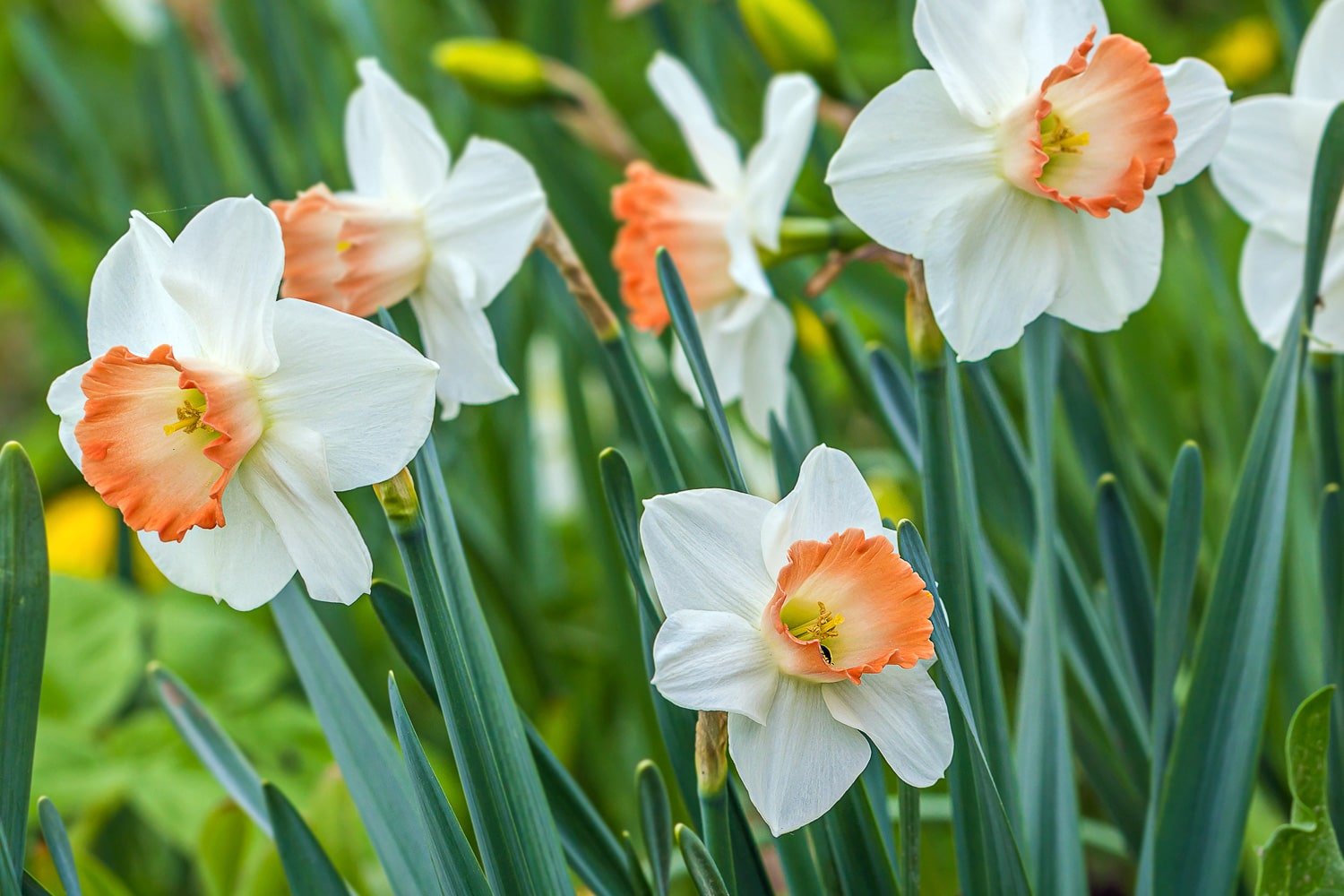
Vibrant Combinations of Daffodil Colors
Daffodils are renowned for their vibrant colors, which range from golden yellow to orange and even white. These stunning blooms bring a burst of color to gardens and landscapes, signaling the arrival of spring with their cheerful hues.
A Stunning Array of Colors
The first color that often comes to mind when we think of daffodils is yellow. Yellow daffodils, with their trumpet-shaped blooms, are the epitome of spring. They symbolize renewal and new beginnings, bringing joy and warmth to any garden they grace.
But daffodils offer more than just yellow flowers. Some varieties of double daffodils bloom in shades of pink, adding a delicate touch to your spring landscape. Like the Thalia variety, pink daffodils showcase creamy-white petals with soft pink cups. These elegant blooms create a romantic garden ambiance and make for beautiful cut flower arrangements.
If you’re looking for a pop of vibrant color, consider planting orange daffodils. These fiery beauties add an unexpected twist to traditional spring displays. The bold orange hue creates a striking contrast against green foliage, making them stand out in any garden setting.

Daffodil Coloring Chart
Daffodils, also known as Narcissus, come in various types and colors. Here is a list of some popular daffodil types and their corresponding colors:
Daffodil Type and Color Chart
- Trumpet Daffodils:
- King Alfred (Yellow)
- Dutch Master (Yellow)
- Carlton (Yellow)
- Ice Follies (Yellow with white perianth)
- Large-Cupped Daffodils:
- Pink Charm (Pink cup with white perianth)
- Salome (Pink cup with white perianth)
- Accent (Orange cup with white perianth)
- Replete (Pink cup with white perianth)
- Small-Cupped Daffodils:
- Barrett Browning (Yellow cup with orange-red rim)
- Jack Snipe (White cup with yellow perianth)
- Rip van Winkle (Greenish-yellow cup)
- Double Daffodils:
- Tête-à-Tête (Yellow)
- Cheerfulness (White)
- Yellow Cheerfulness (Yellow)
- Tahiti (Orange and yellow)
- Poet’s Daffodils:
- Pheasant’s Eye (White petals with a small red-orange cup)
- Actaea (White petals with a small orange cup)
- Hawera (White petals with a yellow cup)
- Jonquilla Daffodils:
- Baby Moon (Yellow)
- Sun Disc (Yellow)
- Pipit (Yellow)
- Cyclamineus Daffodils:
- Jetfire (Yellow with orange-red trumpet)
- February Gold (Yellow)
- Rapture (Yellow with orange-red trumpet)
- Trivandrum Daffodils:
- Thalia (White)
- Hawera (White)
- Tresamble (Yellow with white perianth)
- Split-Corona Daffodils:
- Butterfly Daffodil (Yellow with split, butterfly-like corona)
- Twink (White with split corona)
- Cassata (Yellow with split corona)
- Miniature Daffodils:
- Minnow (White with yellow cup)
- Little Gem (Yellow)
- Jenny (Yellow)
Please note that daffodil colors can vary slightly depending on growing conditions, and many more daffodil varieties and hybrids are available, each with unique characteristics. This list should give you a good starting point for exploring the world of daffodils and their colors.
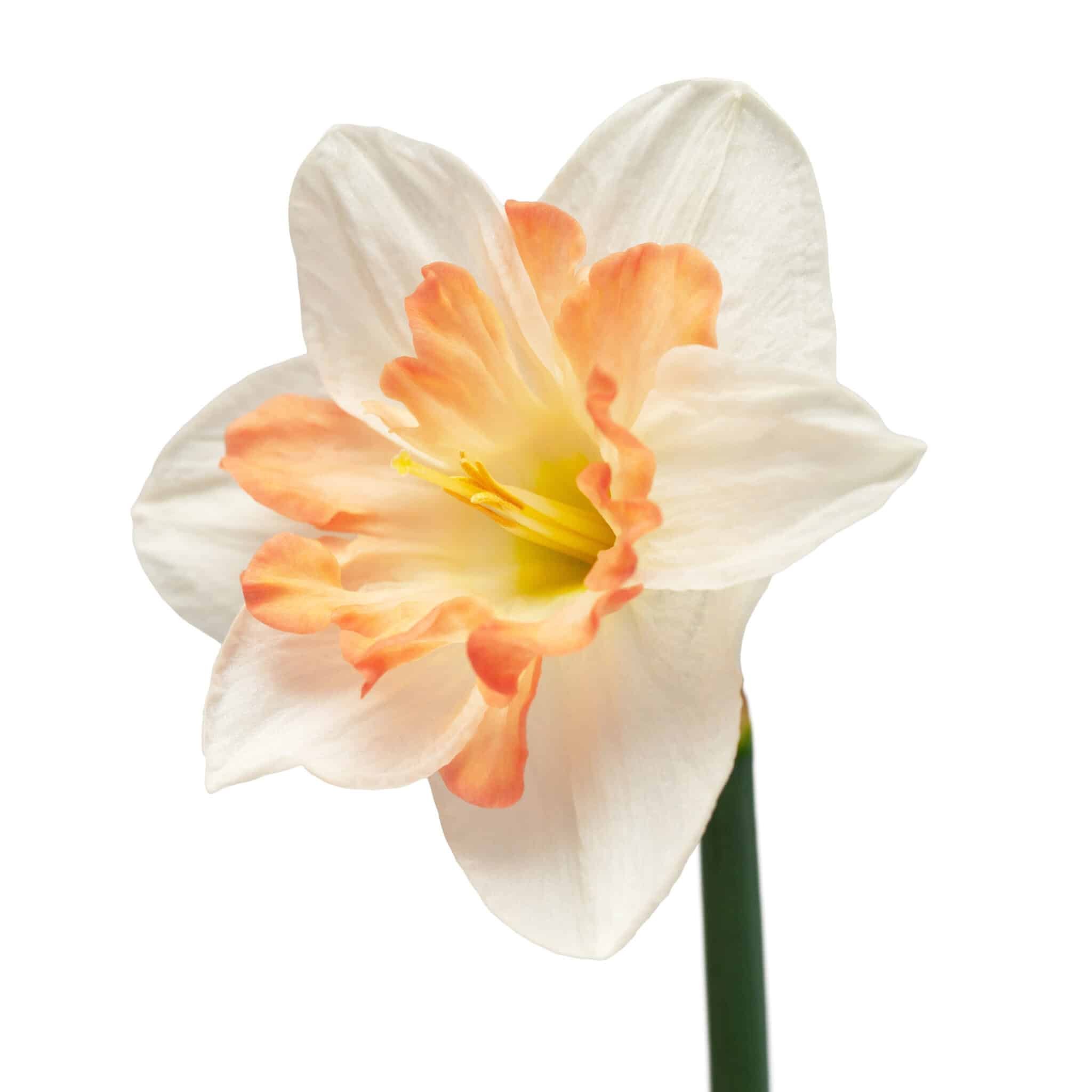
Creating Eye-Catching Combinations
One way to elevate your daffodil display is by experimenting with color combinations. You can create captivating contrasts and harmonious blends by planting different varieties or mixing shades within one variety.
Consider pairing yellow daffodils with pink ones for an eye-catching combination of charm and elegance. The soft pastel tones of the pink daffodil flowers beautifully complement the bright yellow trumpets, creating a delightful visual feast.
For a bolder look, mix orange daffodils with white ones. The stark contrast between these two colors creates a dramatic effect that demands attention. This combination adds depth and excitement to your flower beds or containers.
To achieve a more natural and wild look, combine different daffodil colors and varieties with varying shades of yellow. By intermingling lighter and darker yellows, you can mimic the diversity found in nature. This approach creates a dynamic and visually appealing display that emulates the beauty of a meadow filled with daffodils.
Brecks.com and Brecks.ca both have a wildly colorful assortment of daffodil bulbs to choose from. We’ve had success with Brecks, so we’re confident in recommending them. But seriously, LOOK at these daffodils!
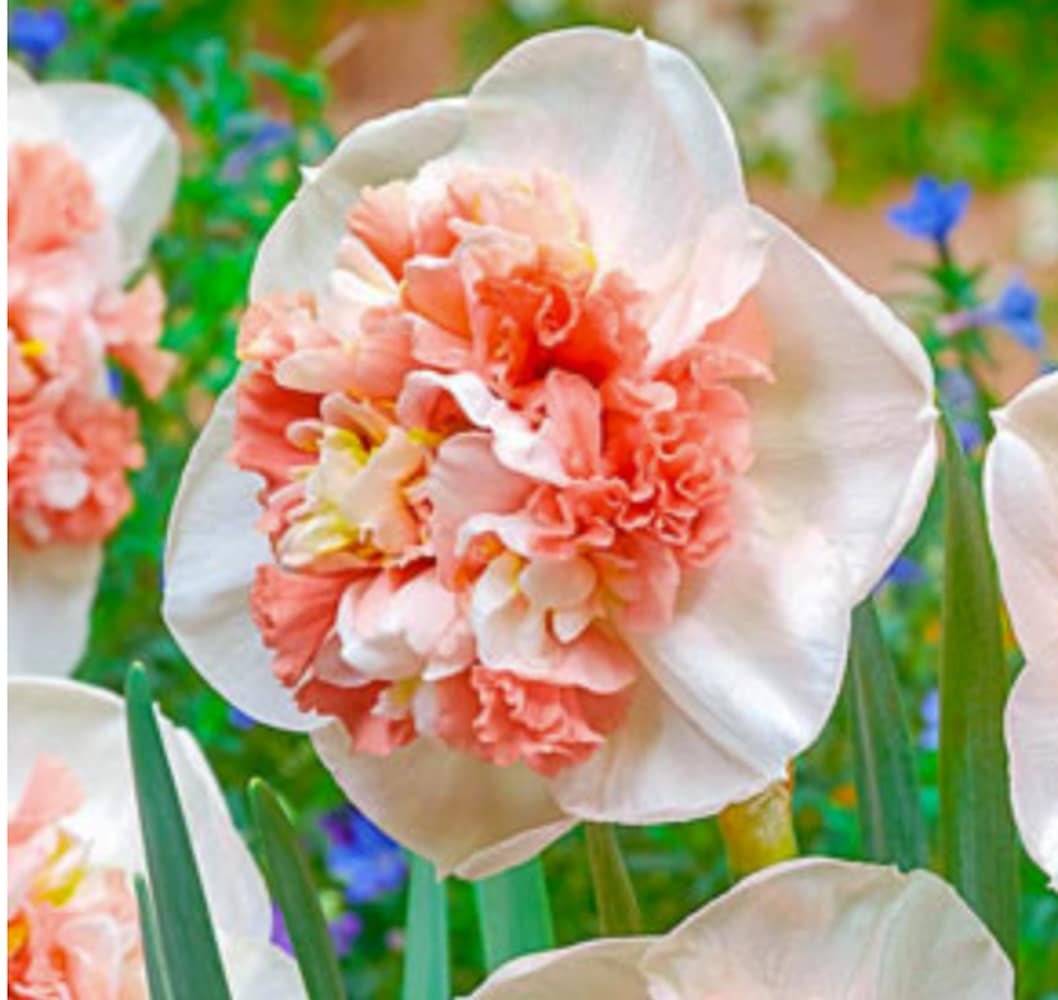


Personalizing Your Daffodil Display
Experimenting with color combinations lets you put your personal touch on your daffodil display. You can choose colors that resonate with your style and preferences, creating a unique and personalized garden.
For a romantic and dreamy ambiance, opt for soft pastel combinations like yellow and pink or white and cream. These gentle hues evoke serenity and tranquility, perfect for creating a peaceful oasis in your outdoor space.
If you’re more drawn to vibrant and energetic displays, go for bold color combinations like orange and yellow, or orange and pure white flowers. These striking contrasts will make a statement in any garden setting, injecting energy into the landscape.
Don’t be afraid to mix different daffodil varieties within one color combination.
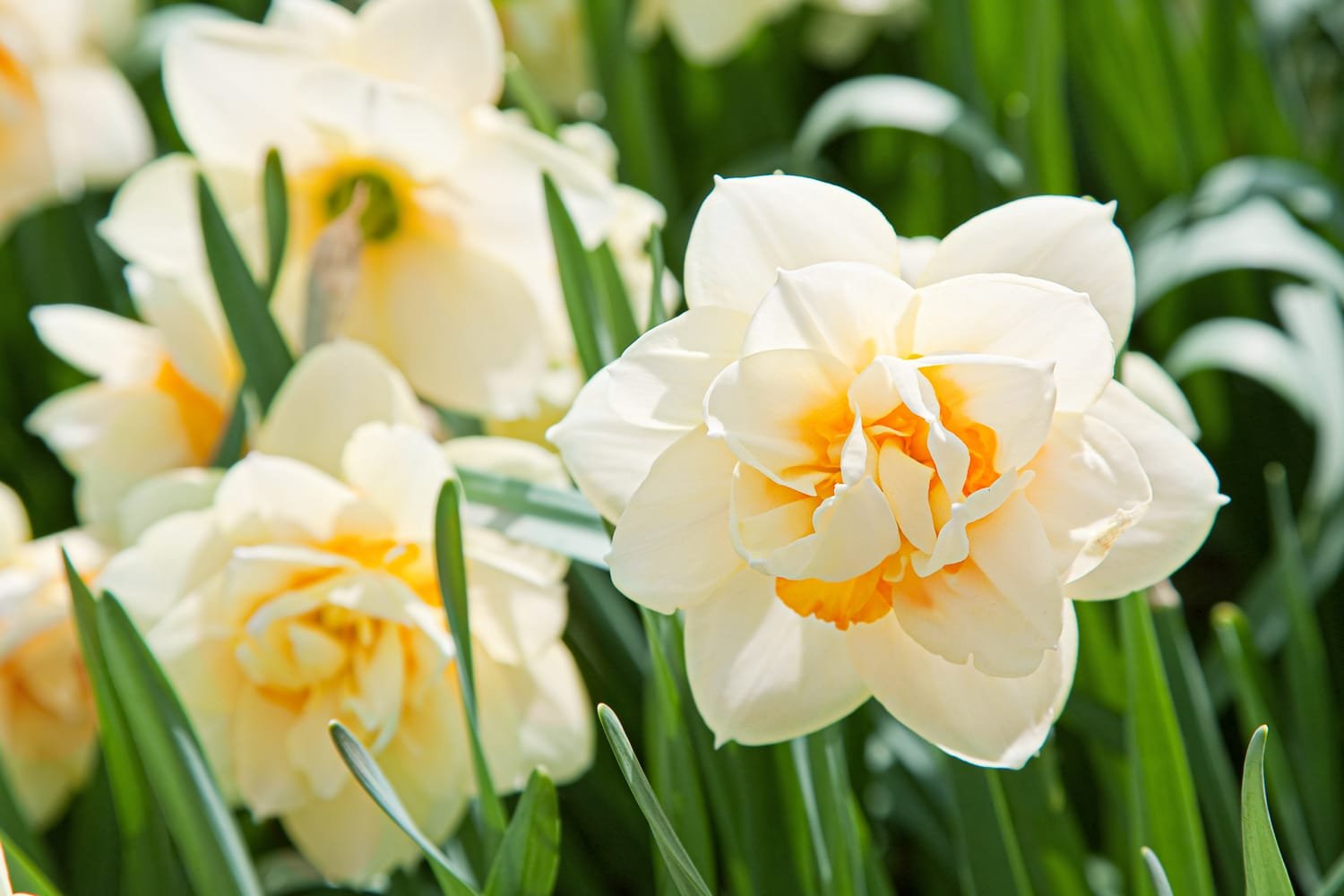
Small Cupped Daffodils with Delicate Charm
Are you looking to add a touch of elegance and whimsy to your garden or floral arrangements? Look no further than small cupped daffodils. These charming flowers feature a delicate yellow cup that is more petite than the petals, creating a unique and enchanting look. With their variety of colors, including soft pinks, creamy whites, and pale yellows, small cupped daffodils will captivate anyone who sees them.
Delicate Varieties Enhancing Your Garden and Floral Arrangements
Small cupped daffodils are known for their delicate charm, which adds an elegant touch to any setting. Whether planting them in your garden or using them in floral arrangements, these varieties will create a whimsical and romantic atmosphere. Their petite cups create a focal point amidst the surrounding petals.
Small cupped daffodils can be planted in clusters or scattered throughout your flower beds in your garden. Their smaller size allows more flexibility in arranging them alongside other flowers without overpowering the overall aesthetic. Imagine a bed of small cupped purple daffodils surrounded by white perianth blooms; it would be like stepping into a fairy tale garden.
These delicate daffodils can bring beauty to any bouquet or centerpiece when used in floral arrangements. Combine them with other fragrant flowers, such as white roses or lilies, for a stunning arrangement that fills the air with sweet fragrance.

A Kaleidoscope of Daffodil Colors
One of the most enticing aspects of small cupped daffodils is their wide range of colors. From delicate shades of pink to creamy whites and pale yellows, these daffodils offer a kaleidoscope of options to suit any preference or design scheme.
Choose small cupped daffodils with white petals for a classic and timeless look. Their pristine appearance adds an air of purity and elegance to any setting. Pair them with white flowers, such as roses or tulips, for a monochromatic arrangement that exudes sophistication.
For those who prefer a touch of color, small cupped daffodils with pink cups are the perfect choice. The soft pink hue adds a gentle pop of color without overpowering the overall aesthetic. These daffodils work beautifully with other pastel flowers like hyacinths or peonies, creating a dreamy and romantic ambiance.
Consider small cupped daffodils with pale yellow petals to add warmth and vibrancy to your garden or floral arrangements. Their sunny disposition brings joy and cheerfulness wherever they bloom.
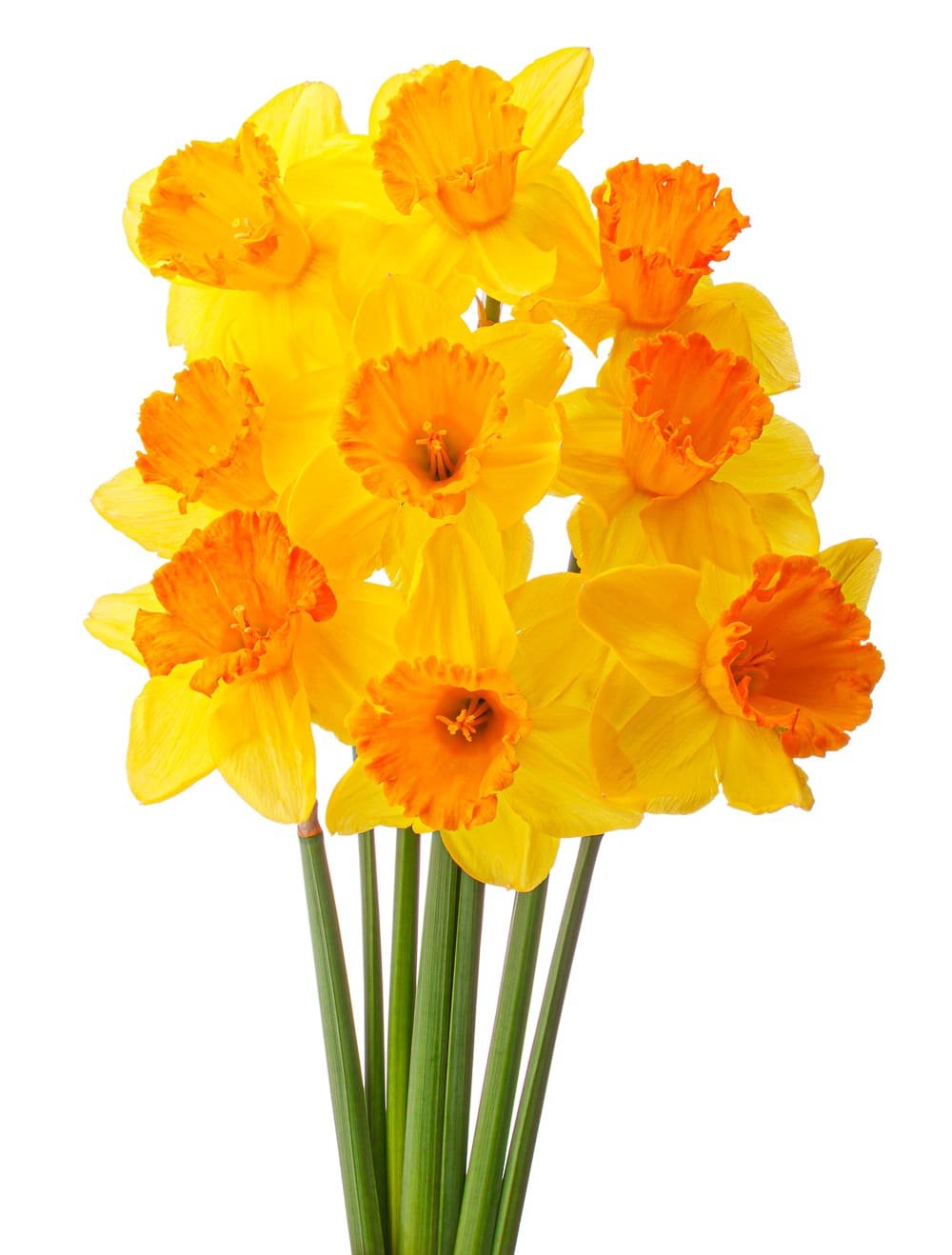
The Finale: Concluding Thoughts on Daffodil Colors
Congratulations! You’ve now explored the wonderful world of daffodil colors and learned about the various types, vibrant combinations, care tips, heirloom varieties, small cupped daffodils, and unique options like Toto, New Baby, and Petit Four. By delving into this fascinating topic, you’ve unlocked a treasure trove of knowledge to enhance your gardening experience.
As you embark on your daffodil-growing journey, let your creativity bloom alongside these colorful flowers. Experiment with different color combinations to create stunning displays in your garden or flower arrangements. Don’t be afraid to mix and match various types of daffodils to add depth and visual interest. And always remember that nature’s palette is vast and diverse – embrace the beauty of each bloom.
Now, it’s time to put your newfound knowledge into action! Get out there and start planting those daffodil bulbs. With love and care, you’ll soon be rewarded with a breathtaking display of vibrant colors that will brighten up any space. So go ahead – unleash your inner gardener and let the magic of daffodils enchant you!
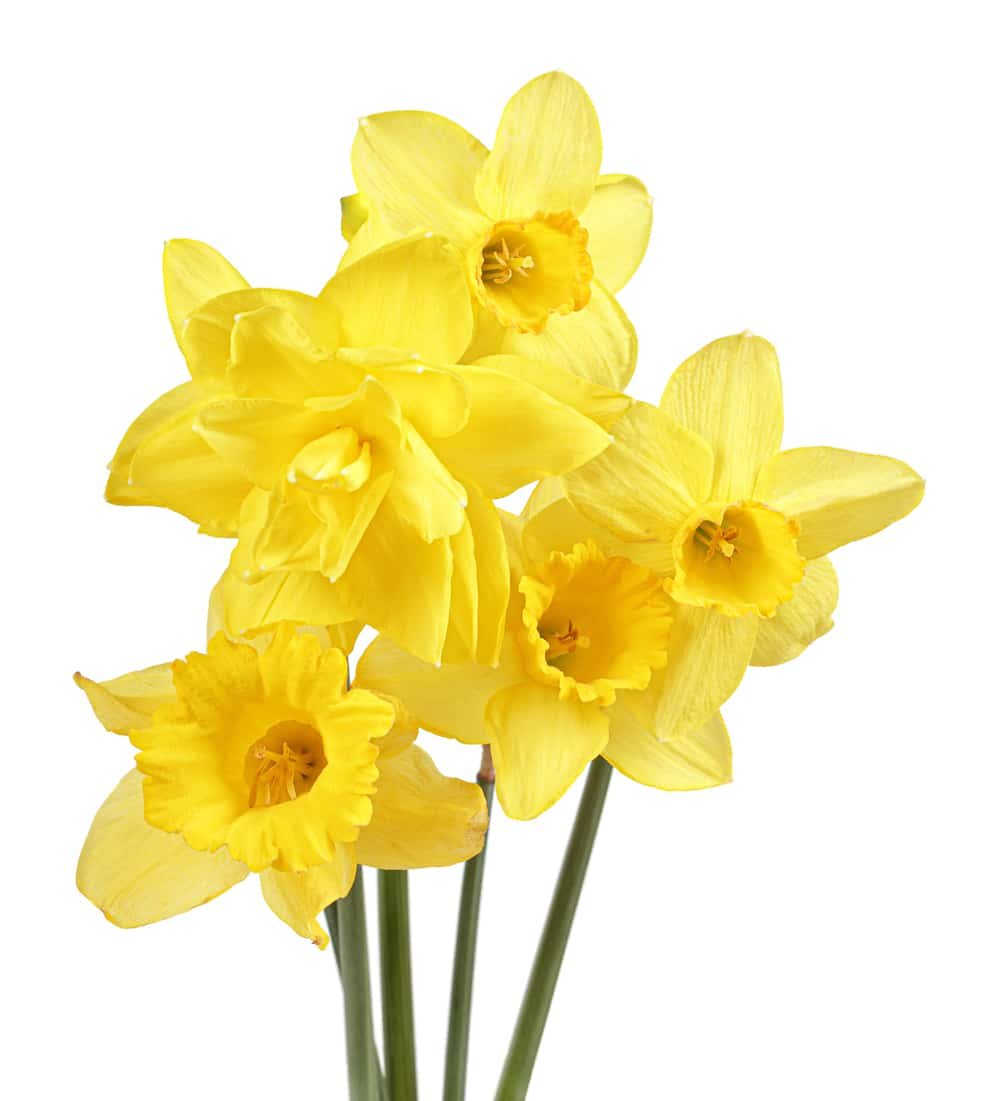
FAQs
Can I plant daffodils in pots or containers?
Yes! Daffodils can thrive in pots or containers as long as they have proper drainage. Use a well-draining potting mix and choose smaller varieties better suited for container gardening.
How often should I water my daffodils?
Daffodils prefer moist soil but do not like to sit in waterlogged conditions. Water them regularly during spring when they are actively growing, but reduce watering once their foliage dies.
When is the best time to plant daffodil bulbs?
The best time to plant daffodil bulbs is in the fall, ideally six weeks before the ground freezes. This allows them to establish roots before winter and ensures a beautiful display of flowers in spring.
Can daffodils grow in shade?
While daffodils prefer full sun or partial shade, they can tolerate some shade. However, too much shade may result in fewer flowers and weaker growth. Aim for at least four to six hours of sunlight daily for optimal blooming.
How do I prevent pests from damaging my daffodils?
To deter common pests like squirrels and rabbits from munching on your daffodil bulbs, consider using protective measures such as wire mesh or planting them alongside more pungent-smelling plants like garlic or onions.

Looking For More Bulb Flower Posts?
We have you covered! We have loads of content about fall and spring bulbs to help you plan a perfect spring and summer garden.

Author: Laura Kennedy
Writer & Owner of Little Yellow Wheelbarrow
Laura is a highly skilled gardener and fervent flower enthusiast. Despite her playful battle with plant spacing guidelines, Laura’s work inspires gardeners to create thriving, beautiful spaces that reflect both creativity and sustainability.












